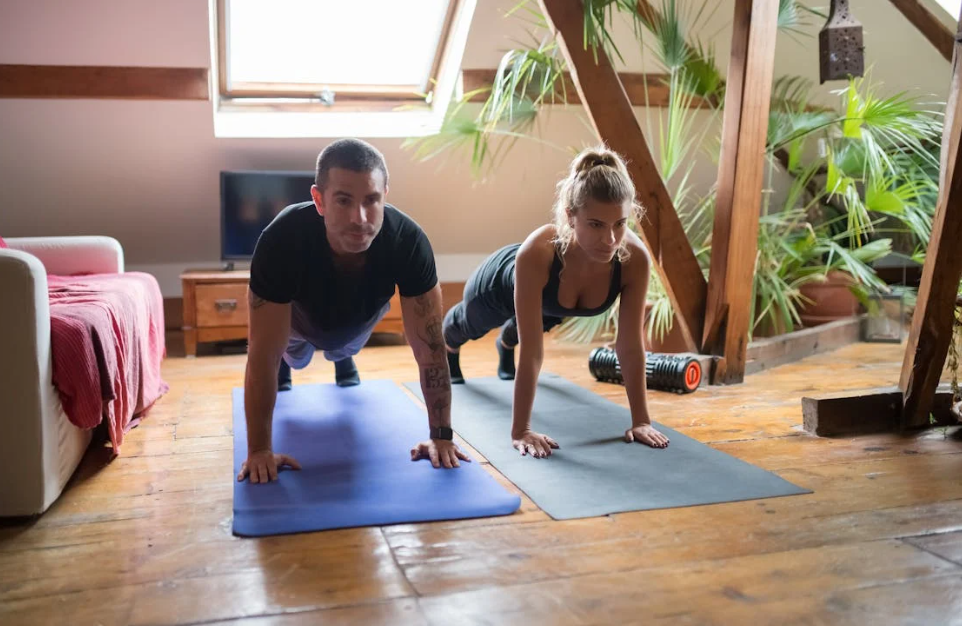The idea of building muscle often brings images of lifting heavy weights in a gym packed with expensive machines. But what if you could achieve a muscular, toned body without ever stepping foot in a gym? Can we truly build muscle at home? The answer is a resounding yes!
Many people believe that home workouts are ineffective because they lack heavy weights and machines. However, this is a myth! With the right approach, dedication, and knowledge, you can achieve significant muscle growth in the comfort of your home.
This guide will cover everything you need to know, from exercises to nutrition, ensuring you maximize muscle growth at home.
Understanding Muscle Growth
Before jumping into workouts, let’s understand how muscles actually grow.
How Muscles Grow
Muscle growth (hypertrophy) occurs when muscle fibers are stressed and break down during exercise. The body repairs and rebuilds these fibers stronger than before. This process is influenced by:
- Resistance training (using body weight, resistance bands, or weights)
- Progressive overload (gradually increasing difficulty)
- Proper nutrition (especially protein intake)
- Rest and recovery (muscles grow when you rest, not during workouts)
Key Factors for Muscle Building at Home
To build muscle effectively at home, you need:
- Challenging Workouts – Exercises must be tough enough to stress muscles.
- Progression – Over time, increase resistance, repetitions, or intensity.
- Good Nutrition – Protein, carbs, and healthy fats fuel muscle growth.
- Rest & Recovery – Muscles need time to repair and grow stronger.
Benefits of Building Muscle at Home
Why train at home instead of the gym? There are several advantages:
Cost-Effective – No need for an expensive gym membership or fancy equipment.
Convenience & Flexibility – Train whenever you want, with no commute or waiting for machines.
No Equipment Needed – Bodyweight exercises can be highly effective.
Privacy & Comfort – No need to worry about gym crowds or intimidation.
Customizable Workouts – You control the pace, exercises, and schedule.
Building muscle at home gives you freedom and flexibility while still delivering great results—if you train smart!
Essential Principles of Muscle Building at Home
To build muscle at home, follow these key principles:
1. Progressive Overload
Your muscles need progressive challenges to grow. This means gradually increasing:
- Repetitions (e.g., from 10 to 15 push-ups)
- Resistance (e.g., adding weight like a backpack)
- Exercise difficulty (e.g., switching from regular to diamond push-ups)
2. Nutrition & Recovery
Without proper nutrition, muscle growth will be slow. Prioritize:
- Protein-rich foods (chicken, eggs, lentils, fish, etc.)
- Complex carbs (oats, quinoa, brown rice) for energy
- Healthy fats (avocado, nuts, olive oil)
- Plenty of water to stay hydrated
Recovery matters too! Aim for 7-9 hours of sleep and avoid overtraining.
3. Consistency & Discipline
Results don’t happen overnight. You need to stick to a structured plan and train regularly to see progress.
Best Bodyweight Exercises for Muscle Growth
Bodyweight exercises are incredibly effective for muscle building. Here are some of the best:
1. Push-Ups (Chest, Triceps, Shoulders, Core)
- Standard Push-Ups
- Wide Grip Push-Ups
- Diamond Push-Ups (Triceps focus)
- Archer Push-Ups (Increased difficulty)
2. Squats & Lunges (Legs & Glutes)
- Bodyweight Squats
- Jump Squats (Explosiveness)
- Bulgarian Split Squats
- Walking Lunges
3. Pull-Ups & Dips (Back & Arms)
If you have a pull-up bar:
- Standard Pull-Ups
- Chin-Ups (Biceps focus)
- Dips using parallel bars or a sturdy chair
4. Core & Abs Exercises
- Planks (Regular, Side, and Weighted)
- Hanging Leg Raises
- Bicycle Crunches
- Russian Twists
These exercises target all major muscle groups, ensuring balanced development.
Using Household Items as Weights
No dumbbells? No problem! Here’s how you can add resistance at home:
🏋️♂️ Water Bottles – Use them as light weights for arm workouts.
🎒 Backpacks – Fill them with books and wear them while doing squats or push-ups.
🪑 Chairs & Tables – Great for dips, step-ups, or incline push-ups.
🏋️ Resistance Bands – Affordable and perfect for strength training.
These simple household items can replace expensive gym equipment and still provide an intense workout!
The Role of Resistance Bands and Dumbbells
While bodyweight exercises are great, adding resistance bands or dumbbells can take your muscle-building to the next level.
How Resistance Bands Help Build Muscle
Resistance bands provide constant tension, making exercises more challenging. They are great for:
Progressive overload – Increase resistance by using thicker bands.
Full range of motion – Helps engage muscles better than weights in some cases.
Joint-friendly training – Less impact on joints compared to heavy weights.
Best exercises with resistance bands:
- Banded squats and lunges (legs & glutes)
- Banded rows and lat pulldowns (back)
- Banded bicep curls and triceps extensions (arms)
Dumbbells for Home Training
If you have dumbbells, use them for weighted squats, deadlifts, presses, and curls to add resistance and accelerate muscle growth.
Effective Workout Routines for Different Muscle Groups
To maximize muscle growth, you need structured routines targeting different muscle groups.
1. Upper Body Workout (Chest, Shoulders, Arms, Back)
Push-Ups (Standard/Wide/Diamond) – 3 sets x 10-15 reps
Pike Push-Ups (Shoulders) – 3 sets x 10 reps
Pull-Ups (If you have a bar) – 3 sets x 8 reps
Dips (Chair/Table) – 3 sets x 10 reps
Bicep Curls (With resistance bands or bottles) – 3 sets x 12 reps
2. Lower Body Workout (Legs & Glutes)
Bodyweight Squats – 3 sets x 15 reps
Bulgarian Split Squats – 3 sets x 10 reps per leg
Lunges (Walking or Reverse) – 3 sets x 12 reps per leg
Calf Raises – 3 sets x 20 reps
3. Core & Abs Routine
Plank (Front & Side) – Hold for 45-60 seconds
Bicycle Crunches – 3 sets x 15 reps per side
Russian Twists – 3 sets x 20 reps
Hanging Leg Raises (If you have a bar) – 3 sets x 12 reps
These workouts target all major muscle groups, ensuring a balanced physique and strength. Increase the reps as you get comfortable.
Creating a Weekly Workout Plan
A structured workout plan is key to seeing results. Here’s a simple schedule:
3-Day Plan (Full Body Focused)
- Day 1: Full-body workout (Push-ups, squats, core)
- Day 2: Rest or light stretching
- Day 3: Upper body & core
- Day 4: Rest
- Day 5: Lower body & core
- Day 6 & 7: Rest or light activity
5-Day Plan (Muscle Group Focused)
- Monday: Upper body (Push-ups, dips, rows)
- Tuesday: Lower body (Squats, lunges, calf raises)
- Wednesday: Core workout (Planks, crunches, Russian twists)
- Thursday: Rest
- Friday: Full-body workout
- Saturday: Active recovery (walking, stretching)
- Sunday: Rest
A consistent plan ensures steady muscle growth while preventing burnout.
Importance of Nutrition for Muscle Growth
Training is just half the battle—nutrition plays a major role in muscle-building.
Protein Intake & Muscle Recovery
Protein helps repair and grow muscles. Aim for 0.7-1 gram per pound of body weight daily.
✅ Best Protein Sources:
- Lean meats (chicken, turkey, fish)
- Eggs & dairy (Greek yogurt, cottage cheese)
- Plant-based options (lentils, chickpeas, tofu)
Best Foods for Muscle Gain
- Carbs for energy (oats, sweet potatoes, quinoa)
- Healthy fats (avocados, nuts, olive oil)
- Hydration – Muscles need water to function properly!
Sample muscle-building meal:
🥚 Breakfast: Scrambled eggs + whole wheat toast
🍗 Lunch: Grilled chicken + quinoa + veggies
🥜 Snack: Greek yogurt + almonds
🐟 Dinner: Salmon + brown rice + steamed broccoli
Rest and Recovery: The Hidden Key to Growth
Muscles don’t grow during workouts—they grow when you rest!
Why Rest is Crucial
🚀 Allows muscles to repair & grow
😴 Improves hormone balance (Testosterone & Growth Hormone)
🛑 Prevents overtraining & injury
How to Optimize Recovery at Home
- Sleep 7-9 hours per night
- Stretch & foam roll to reduce soreness
- Eat enough protein to fuel muscle repair
- Take rest days seriously—don’t train every day!
Ignoring recovery slows down muscle growth, so prioritize rest!
Tracking Progress and Staying Motivated
Progress can be slow at first, but tracking results keeps you motivated.
How to Measure Muscle Growth at Home
📏 Take body measurements (chest, arms, legs)
📸 Take progress photos every 2-4 weeks
🏋 Track reps & weights (increase over time)
Tips to Stay Consistent
- Set small, achievable goals (e.g., “Do 20 push-ups without stopping”)
- Find a workout buddy to stay accountable
- Listen to music or podcasts to stay motivated
- Celebrate small wins—every rep counts!
Common Mistakes to Avoid
Overtraining – More is NOT always better. Rest is crucial.
Poor Form – Avoid injuries by using proper technique.
Skipping Nutrition – Diet is just as important as workouts.
Lack of Progression – Always challenge yourself to improve.
Avoiding these mistakes ensures steady progress and prevents burnout.
Building a Home Gym on a Budget
You don’t need expensive equipment, but having a few basics helps.
💪 Must-Have Equipment:
- Resistance bands ($10-$30)
- Dumbbells or adjustable weights ($50-$100)
- Pull-up bar ($20-$40)
- Yoga mat ($10-$20)
Budget tip: Look for second-hand fitness gear online!
Conclusion
So, can you build muscle at home? Absolutely! With bodyweight exercises, resistance training, proper nutrition, and consistency, you can achieve impressive muscle growth without a gym.
The key is progressive overload, nutrition, and recovery. Stick to your plan, stay patient, and you’ll see results.
Now it’s time to take action—start your home muscle-building journey today!
FAQs
1. Can I build muscle at home without weights?
Yes! Bodyweight exercises like push-ups, squats, and pull-ups can build muscle effectively, especially when done with progressive overload.
2. How long does it take to see muscle growth at home?
It depends on consistency and effort. You may see changes in 4-6 weeks, but significant muscle growth takes 3-6 months.
3. Do I need to eat more to build muscle at home?
Yes. To build muscle, you need to consume more calories than you burn, with plenty of protein and healthy carbs.
4. Can I build muscle with just push-ups?
Push-ups target the chest, shoulders, and triceps but for full-body growth, combine them with squats, pull-ups, and core exercises.
5. Should I train every day to build muscle?
No! Muscles grow during rest. Train 3-5 days a week and allow proper recovery time.





